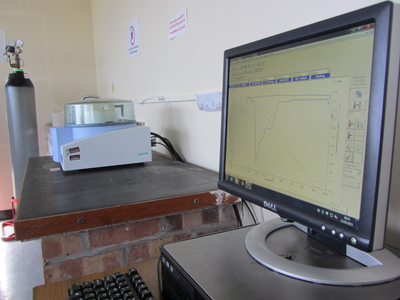Environmental Material Characterisation
The Quaternary Environmental Change Laboratories at Liverpool specialise in the non-destructive analysis of soils and sediments, generating records of environmental change from marine, coastal, lacustrine, fluvial, wetland and aeolian sedimentary sequences. Recent research highlights include: robust testing the performance of µXRF core scanners relative to dry sediment mass specific measurements on ED-XRF, and discerning modes of sediment transport and deposition for coastal back-barrier environments from particle size data measured on our Coulter Laser Granulometer.
Organic carbon analyses, including the speciation of organic components, are undertaken by thermogravimetry (TGA) and differential scanning calorimetry (DSC) across 30°-1000°C under Nitrogen and Air atmospheres on a PerkinElmer STA6000. The mass losses under Nitrogen atmosphere allow organic phases to be distinguished, for example for a range of lake sediments pyrolysis 150-350°C appears to reflect plant tissues and algal matter, 350-535°C more mature thermally soil humic compounds, 550-675°C charred particles and charcoal and 670-880°C carbonates. Routine organic content measurements are support by ignition in furnaces to 1000°C.

Particle shape and size analysis is supported by automated sieving, three Coulter Laser granulometers (0.5-2000 µm) and a Malvern Morphologi G3 particle characterization facility for the measurement of particle size and particle shape (0.5-6000 µm). Full particle size and shape analyses can be carried out, including pre-treatments of sediments for organic content.
Inorganic geochemistry is carried out for sediments, soils and waters on a dry-mass and non-destructive basis (down to Na) using our Bruker S2 Ranger energy-dispersive X-ray fluorescence (XRF) analyser. µXRF scanning of cores (wet and dry) is available using the Liverpool Geotek Multi-Sensor Core Logger (MSCL) fitted with an Olympus portable XRF (with parallel measurement of magnetic susceptibility, UV-VIS diffuse reflectance spectrometry and high resolution core photography). Field and geochemistry in remote areas (down to Mg) is available using a suite of Thermo-Niton handheld XRF analysers. Atomic absorption spectrophotometry (Thermo) measures the absorption of light at a specific wavelength by a sample, with geochemical data (e.g. Fe, Hg) obtained as each element absorbs a unique energy wavelength linearly related to concentration.
Sediment composition on a mineralogical and organic compound basis is supported by ultraviolet/visual light (UV/VIS) and Fourier-transform infrared (FTIR) spectrometry. The spectral signatures of soils and sediments are defined reflectance/absorbance characteristics relative to wavelength. The spectral responses reflect electronic transitions of atoms and vibrational stretching and bending of structural groups of atoms that form molecules and crystals. Our Bruker Alpha Fourier Transform Infrared spectrometer is used to liquids, powders and pressed materials for material composition (e.g. mineralogy and organic compounds) on a transmission, diffuse reflectance and Platinum ATR basis.Visual and near-infrared (VNIR) diffuse reflectance spectroscopy (DRS) on our Thermo Evolution 300 UV-VIS Spectrophotometer provides compositional information on powders, liquids and pressed pellets (e.g. hematite / goethite in soils).
Environmental Magnetism facility enables analysis of sediments for Magnetic Susceptibility (ambient and variable temperature), KLY-3 Kappabridge susceptibilty system, Molspin fluxgate spinner magnetometers (IRM measurements), in field Molspin Vibrating Sample Magnetometer, ASC Scientific alternating-field demagnetizer with partial ARM capability and various magnetisers and demagnetisers (fields up to 7 T). The facility established by Prof Frank Oldfield (1996) is capable of a full suite of environmental magnetic measurements.